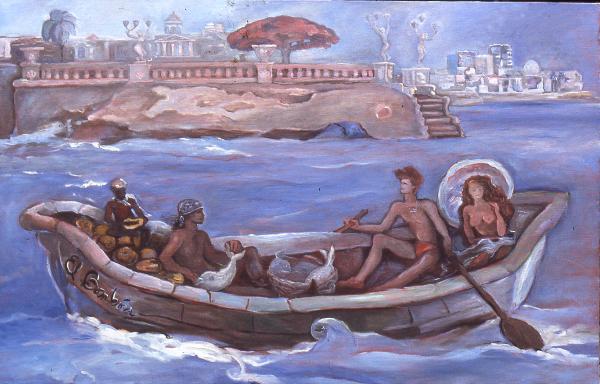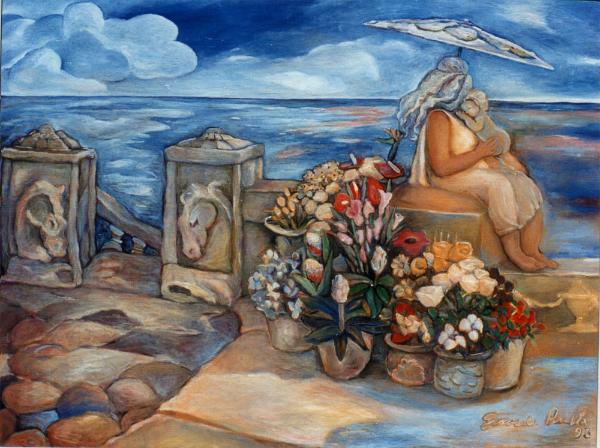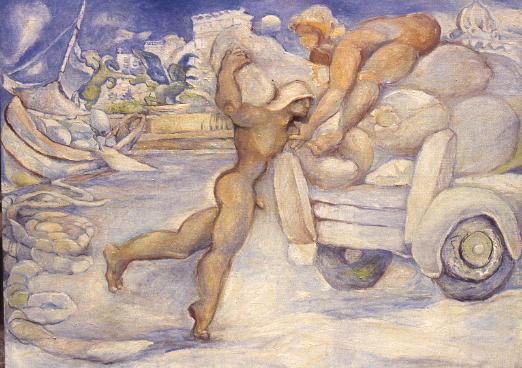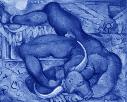| Toroazul Painting and Fine Arts |

| A n d r o m e d a 30 " x 40 " oil on canvas 1995 Private Collection |
Andromeda was a princess who was chained to a rock by her parents, two ancient
Ethiopian monarchs named Cassiopeia and Cepheus. The girl was very conscious of
her beauty, and she boasted that that her fine looks exceeded the beauty of all the
female sea-divinities or "nereids" in Poseidon's ocean. Offended, the nereids asked
the god of the ocean to punish the princess and her city, and Poseidon sent a sea
monster to ravage the country. Meanwhile, an oracle told the king and queen that
Ethiopia would be spared if they offered their daughter Andromeda to the monster as
expiation.
In this mythological work, I painted the moment that the hero Perseus arrives to
rescue the girl and kill the sea dragon. (Perseus's face appears on the boat's sail.)
Perseus would only be able to overpower the monster by first killing another monster
or gorgon, the MEDUSA, by cutting off her head before she turned him to stone,
which was the terrible gorgon's most deadly power. Anyone who looked at the face
of the Medusa was literally petrified . . . or turned to stone.
To represent Perseus's victory over Medusa, I painted a miniature version of French
painter Théodore Gericault's own "Raft of the Medusa" (1819) , not only as a
reference to that great work of art, but as a reminder that an artist's challenge in
composing a canvas is similar to the hero's encounter with the terrible Medusa. Great
artists often go on to achieve the unachievable after they have faced some prior
obstacle, like fear. (CLICK here to view Gericault's masterpiece.)
Ethiopian monarchs named Cassiopeia and Cepheus. The girl was very conscious of
her beauty, and she boasted that that her fine looks exceeded the beauty of all the
female sea-divinities or "nereids" in Poseidon's ocean. Offended, the nereids asked
the god of the ocean to punish the princess and her city, and Poseidon sent a sea
monster to ravage the country. Meanwhile, an oracle told the king and queen that
Ethiopia would be spared if they offered their daughter Andromeda to the monster as
expiation.
In this mythological work, I painted the moment that the hero Perseus arrives to
rescue the girl and kill the sea dragon. (Perseus's face appears on the boat's sail.)
Perseus would only be able to overpower the monster by first killing another monster
or gorgon, the MEDUSA, by cutting off her head before she turned him to stone,
which was the terrible gorgon's most deadly power. Anyone who looked at the face
of the Medusa was literally petrified . . . or turned to stone.
To represent Perseus's victory over Medusa, I painted a miniature version of French
painter Théodore Gericault's own "Raft of the Medusa" (1819) , not only as a
reference to that great work of art, but as a reminder that an artist's challenge in
composing a canvas is similar to the hero's encounter with the terrible Medusa. Great
artists often go on to achieve the unachievable after they have faced some prior
obstacle, like fear. (CLICK here to view Gericault's masterpiece.)

| T h e r a p e o f H e l e n 32 " by 48 " oil on canvas 1995 Private Collection |
Helen and Paris probably passed by Havana on their way to Troy!
Or so I was thinking when I painted this canvas inspired in the story of
the rape of Helen of Troy, another beautiful woman from Western
history and art.
The painting's title in Spanish, "El bombón de Elena", comes from an old
Cuban cha-cha-cha from the 1950s that I heard and enjoyed as a young
boy in Cuba. The song's lyrics are superficial and silly,
Elena come bombón,
¡qué bueno está el bombón de Elena! ,
Too often, the myths of classical antiquity are retold in too serious a
manner, and this can hide the humor or irony that makes those very tales
powerful.
Or so I was thinking when I painted this canvas inspired in the story of
the rape of Helen of Troy, another beautiful woman from Western
history and art.
The painting's title in Spanish, "El bombón de Elena", comes from an old
Cuban cha-cha-cha from the 1950s that I heard and enjoyed as a young
boy in Cuba. The song's lyrics are superficial and silly,
Elena come bombón,
¡qué bueno está el bombón de Elena! ,
Too often, the myths of classical antiquity are retold in too serious a
manner, and this can hide the humor or irony that makes those very tales
powerful.
| E s t i v a d o r s 30 " by 40 " oil on canvas 1995 Private Collection |
This canvas was a small "dreamlike" tribute to the workers of ports like
Cartagena, Colombia, in the Caribbean, whom I imagined as nudes in a
landscape. To me the Caribbean is similar to the Mediterranean Sea (the
Mare Nostrum of antiquity) --- a treasurehouse for the artist.
Cartagena, Colombia, in the Caribbean, whom I imagined as nudes in a
landscape. To me the Caribbean is similar to the Mediterranean Sea (the
Mare Nostrum of antiquity) --- a treasurehouse for the artist.

| W a i t i n g b y t h e s e a w a l l 30 " by 40 " oil on canvas 1993 Private Collection |
There is nothing really mythological about this canvas, except perhaps the
horses' heads -- as horses were the animals of the sea-god Poseidon in
antiquity. To me, this painting is a tribute to motherhood and to the virtue of
knowing how to wait in silence for something long-desired.
horses' heads -- as horses were the animals of the sea-god Poseidon in
antiquity. To me, this painting is a tribute to motherhood and to the virtue of
knowing how to wait in silence for something long-desired.

